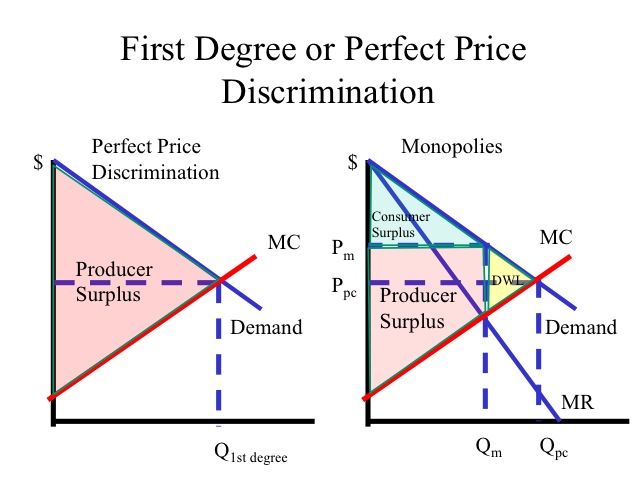Price discrimination is best described as a monopolist. That way rm will be making pro ts from both fee and marking up the price.
Price discrimination requires a firm to have at least some market power.

. A monopoly is facing a non-linear inverse market demand given by P 100p Q and has cost function C 20 10Q. For a monopolist that engages in price discrimination when the price elasticity in market 1 is less in absolute value than in market 2 the optimal price in market 1 will exceed the optimal price in market 2. C by charging a lower price to consumers whose demand is more elastic.
Uses price discrimination to price products higher than the marginal cost of production. 350 for the same commodity from customer Y the seller or the firm is practicing price. D by charging the same price to all consumers.
So long as the price-discriminating monopolist manages to reap part of the consumers surplus his total revenue and his total profits will be higher even if he sells the quantity 0X which is defined by the intersection of his MC with his Original aggregate MR curve. It is more usual however to find that a monopolist sells identical products to different buyers at different. What are the profits of the firm if it is a monopolist but cannot engage in price discrimination.
This means that any firm that is not perfectly competitive has the ability to price discriminate. If the monopolist charges different prices from different customers for the same commodity the phenomenon is called price discrimination and the monopoly is termed as discriminating monopoly. The marginal cost of production is only 090 and 125.
A discriminating monopoly is a single entity that charges different prices which are not associated with the cost to. B charging buyers an excessive price for the product. Charging different customers different prices when the costs are equal.
Selling a product for. Lower the price for the group of consumers with the more elastic demand and A. By charging a higher price to consumers whose demand is more inelastic.
A monopolist engages in price discrimination. What are the profits of the monopolist if it engages in perfect. Charging buyers an excessive price for the product.
By charging the same price to all consumers. For instance when a seller charges Rs. Price discrimination is best described as a monopolist.
Regular coffee is priced at 1 while premium coffee is 250. B by charging a higher price when marginal cost is lower. Draw the graph showing producer equilibrium for a monopoly with demand marginal revenue and marginal cost curves.
Monopoly means absence of competition. A by charging a higher price to consumers whose demand is more elastic. What price would the firm charge if it were a monopolist but could not engage in price discrimination.
By charging a lower price when marginal cost is higher. 1 Monopoly and Price discrimination Definition and Meaning of Monopoly. Asked Aug 9 2018 in Economics by Andrea.
It is an extreme situation in imperfect competition. Selling a product at the fixed market determined price. Raise the price for the group with the less elastic demand.
Price discrimination is a selling strategy that charges customers different prices for the same product or service based on what the seller thinks they can get the customer to agree to. Charging same prices to different customers when the costs are different. A monopolist engages in price discrimination.
Also known as perfect price discrimination first-degree price discrimination involves charging consumers Buyer Types Buyer types is a set of categories that describe spending habits of consumers. Discriminating monopoly or price discrimination occurs when a monopolist charges the same buyer different prices for the different units of a commodity even though these units are in fact homogeneous. Derive rms MRand MC curves calculate pro t-maximizing price and quantity if the rm is charging single price.
By charging a lower price to consumers whose demand is more inelastic. Price discrimination is best described as a monopolist a selling a product at one price and a perfectly competitive firm selling an identical product at another price. Charging buyers an excessive price for the product.
The prices are usually not associated with the cost of the product or service provision. Monopolist can excercise price discrimination because he is having complete control over the price of product produced by him. The firm will A.
It denotes a single seller or producer having the control over the market. Such a situation is described as perfectly discriminating monopoly. B 4 c 8 d 1450.
Asked Apr 26 2020 in Economics by Jenny. However the quantity that the discriminating monopolist supplies will be higher than OX if he can charge. Selling a product at the fixed market determined price.
A discriminating monopoly is an entity charging different prices for its services or products in different markets or consumers. By using price discrimination the seller makes more revenue even off of the price sensitive consumers. A monopoly may be defined as a condition of production in which a single person or a number of.
For now well focus on monopoly. 500 for a commodity from a customer X and Rs. Demand clients at that price.
Charging different customers different prices when the costs are equal. A 24 b 20 c 1850. Consumer behavior reveals how to appeal to people with different habits the maximum price that they are willing to pay for a good or service.
Suppose a firm starts with a single price then switches to a price discrimination scheme. The possibility of price discrimination is found generally in monopoly form of market where monopolist charges different prices from different consumers for the same product commodity.



0 Comments